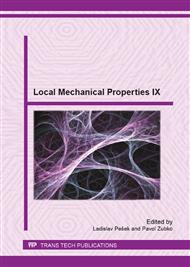p.174
p.178
p.182
p.186
p.190
p.194
p.198
p.202
p.206
On the Indentation Modulus of Sintered Materials
Abstract:
When the depth-sensing (nano)indentation is applied to sintered samples, measured properties, which are expected to represent the material of an individual grain, seem to depend on the overall porosity of the macroscopic sample. To understand such a result, it is assumed that while the nanoindenter penetrates into the surface grain and probes the properties of its material, the grain itself serves as another, larger indenter indenting the rest of sample and probing the properties that represent the bulk of material rather than individual grains. Load vs. displacement curve reflects the synergetic response of these two “indenters” and so it contains information about the sample’s mechanical properties at both microscopic and macroscopic scales. Obtained theoretical results agree qualitatively with the experimental data (the dependence of the indentation modulus on the porosity of sample; the indentation size effect).
Info:
Periodical:
Pages:
190-193
Citation:
Online since:
September 2013
Authors:
Price:
Сopyright:
© 2014 Trans Tech Publications Ltd. All Rights Reserved
Share:
Citation:


